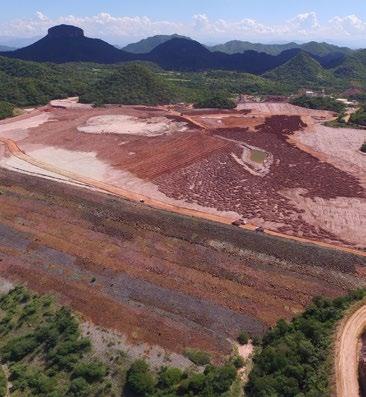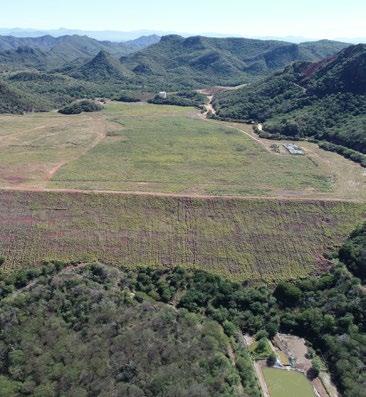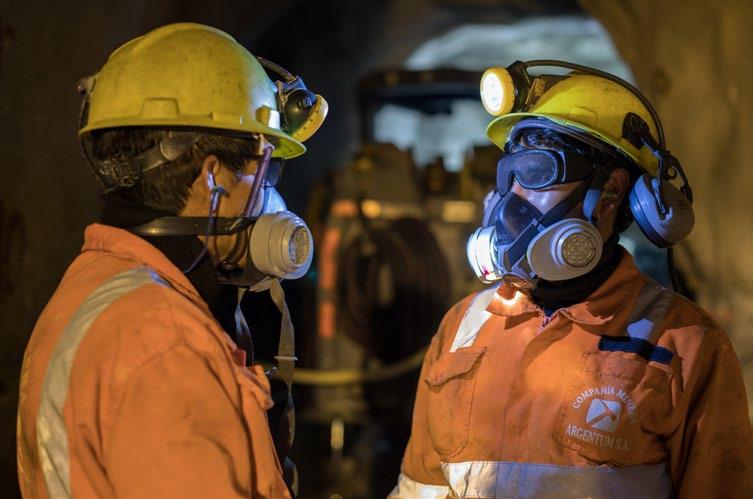
5 minute read
biodiversity and mine closure
Why are biodiversity and mine closure important?
Mining activities require the development of infrastructure, which alters the natural features of the local landscape. Open pit mines, processing plants, mine waste rock facilities, ancillary facilities, supporting infrastructure construction and roads can damage habitat, impact individual species, and affect overall ecosystem health. Mines have finite lifespans, and mining companies are responsible for managing their impacts not only during mine operations, but also after mine closure. This means restoring land to a beneficial state and ensuring no health and safety risks remain from the mining wastes, equipment, and infrastructure left behind. At Pan American Silver, our desire to leave a positive beneficial legacy in our host communities means that we engage local communities and governments in planning mine closure before a mine is in operation.
POTENTIAL RISKS AND IMPACTS
Potential damage to ecosystem health and loss of biodiversity
New or unanticipated closure, reclamation and remediation costs, and regulatory requirements
RELATED SDGS
Hydroseeding for reclamation of waste rock dumps at Manantial Espejo.
Our Approach
We ensure that protected and critical habitats and species are identified and appropriately protected before, during, and after mining. In mine closure our objective is to return the land disturbed by our activities to as close to its natural and beneficial state as possible and create viable habitats for native species of the local area. We work to make the transition from operations to closure as efficient as possible by starting the planning process early and collaborating with local communities. Our approach includes:
System
• Biodiversity and Mine Closure Corporate Environmental Standard – This standard provides best practice guidance for our sites.
Programs and initiatives
• Ecosystem baseline studies – We conduct detailed flora, fauna, and ecosystem baseline studies to identify potentially sensitive habitats and species prior to commencement of mining and/or significant changes to our operations. • Reclamation plans – Each site’s reclamation plan includes measures to enhance biodiversity conservation. • Biodiversity management plans – Each site has a plan to manage biodiversity during construction, operation, and closure. Where protected species have been identified(1), we implement detailed impact assessments, management plans, and conservation strategies. • Closure plans – Each mine has a closure plan, and we update detailed closure costs estimates for all mines and projects on an annual basis. • Engagement – We engage with local communities and other COIs to ensure that their closure and post-closure expectations are considered.
Monitoring and evaluation
• TSM Biodiversity Conservation Management Protocol and Mine Closure
Framework – Our mines self-assessed their performance against the protocol and are implementing action plans for improvement. • Biodiversity monitoring – We monitor biodiversity at all our sites to identify potential new impacts and compare results with our baseline studies. • Post-closure monitoring and maintenance – All our closure plans include many years of post-closure monitoring to ensure reclamation objectives are achieved. In mine closure our objective is to return the land disturbed by our activities to as close to its natural and beneficial state as possible and create viable habitats for native species of the local area.
Our Performance
Minimizing Impacts on Biodiversity
None of our mines are located in areas that are designated as having high biodiversity value as defined by GRI.(1) Land owned by our Huaron mine in Peru is adjacent to the Huayllay “Stone Forest” National Sanctuary (a natural geological rock formation resembling pillars and other structures);(2) however, the mine operation is located more than 4km from the Sanctuary boundary, and our nearest infrastructure, a camp and water treatment plant, is located over 0.7km from the Sanctuary, beside the town of Huayllay.
Baseline studies and monitoring have not identified any significant impacts on biodiversity from our operations. In fact, for some of our sites, ongoing monitoring shows an increase in biodiversity as well as in flora and fauna population densities following years of impacts from agriculture and ranching activities. This occurs where we have purchased and secured large areas of land but require only a small portion for our operations. The remaining unused land is protected from grazing and hunting activities that has led to significant natural habitat recovery. For example, in Argentina we own more than 57,000 hectares of land that is located outside of our operations and is protected from impacts such as sheep grazing and hunting. Flora and fauna surveys on this land over recent years have shown an increase in abundance and diversity of species in the ecosystem. At our Dolores mine we continue to restore 40 hectares of community land that was previously affected by cattle over-grazing and natural erosion in order to provide habitat for native fauna.
Reclamation
We conduct progressive closure activities, reclaiming disturbed land and waste rock facilities once they are no longer required by our operations. At the end of the mining lifecycle, we create landforms that integrate back into the natural landscape and provide quality habitat. This requires removing physical infrastructure and reclaiming remaining waste rock and tailings storage facilities. By the end of 2019, the accumulated area disturbed and not yet reclaimed by all our operations was 3,130 hectares. We reclaimed 126 hectares, primarily at Alamo Dorado. We conduct progressive closure activities, reclaiming disturbed land and waste rock facilities once they are no longer required by our operations.
(1) Defined by GRI as an area not subject to legal protection, but recognized for important biodiversity features by a number of governmental and non-governmental organizations. (2) Huaron’s operations are approximately 300ha in size and located southwest of the Huayllay Sanctuary, which is a “stone forest” formed by volcanic activity.


Mine Closure
Production at our Alamo Dorado mine ceased in 2017, and we completed the active physical closure process during early 2019(1). We are now in the postclosure stage monitoring, which entails on-going environmental sampling and analysis to evaluate erosion, revegetation survival, habitat recovery, water quality, biodiversity, and geotechnical & geochemical stability. We currently manage water treatment at the site to mitigate acid rock drainage while passive treatment systems are being established.
We continue to apply the lessons learned from our Alamo Dorado closure project to annual Closure and Decommissioning Liability estimates for all our mines and projects. In 2019, we successfully incorporated the new Shahuindo and La Arena operations into our standard estimating methodology.
Next Steps
• Continue site-level implementation of the TSM Biodiversity Conservation
Management Protocol and our Corporate Environmental Standard on
Biodiversity and Mine Closure. • Continue post-closure monitoring and maintenance at Alamo Dorado. • Update closure planning for Manantial Espejo and La Arena.
Click here to see additional biodiversity performance data:
• MM1 Amount of land disturbed or rehabilitated • 304-3 Habitats protected or restored






